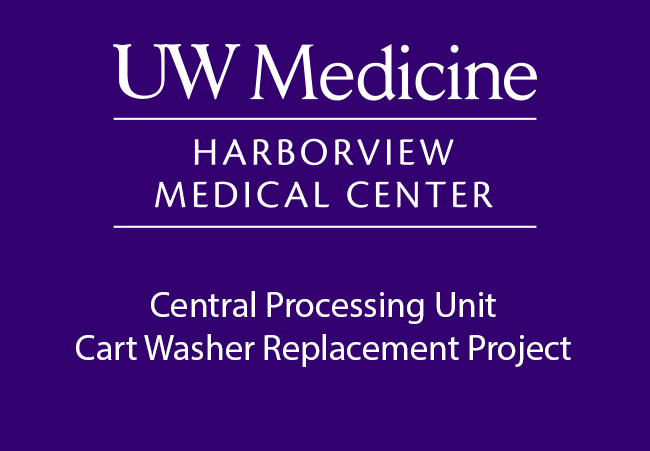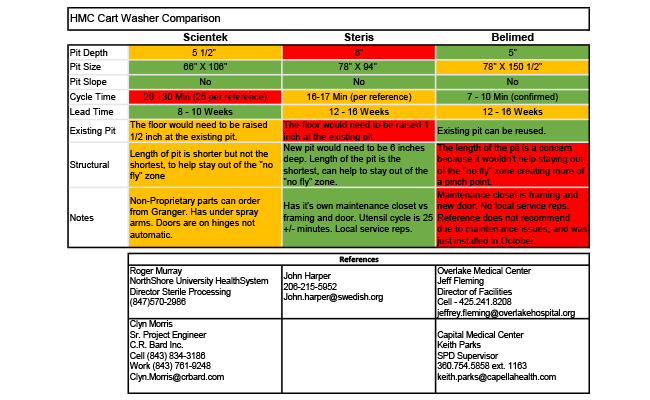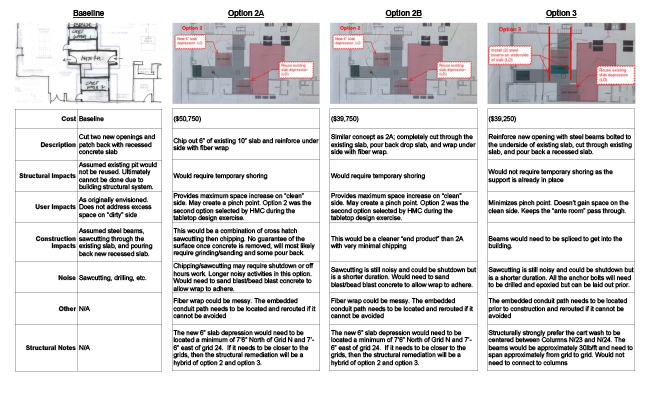
Value-Based Decisions at Harborview Medical Center
With the wealth of information and choices available today, it’s easy for project teams to become overwhelmed and even paralyzed when weighing options and trying to make key decisions. Regardless of a project’s size and scope, Mortenson takes an active role in the decision-making process by providing our customers with the timely, well-organized information needed to make informed and value-based decisions.
On the design-build Harborview Medical Center Central Processing Unit (CPU) upgrade project, the customer was faced with two major decisions that would greatly impact the project’s outcomes: (1.) which manufacturer’s equipment to purchase, and (2.) where the new cart washer should be located. To aide with the first, our team met with each of the preferred manufacturers and studied cut sheets to learn the individual benefits of each model and evaluated their construction impacts (e.g. constructability, infrastructure needs, structural implications). Mortenson then compiled the information into a single document (see figure A) including the evaluation criteria for each: wash cycle times, lead times, maintenance considerations, availability of spare parts, and construction impacts . For each manufacturer the team included local references where the same equipment was being used and offered to coordinate offsite visits. By providing only the pertinent selection criteria in a format that made it easy to compare, our customer was able to focus their efforts on what really mattered, resulting in a timely decision that allowed our design-build team to keep the design progressing on schedule.

Figure A
Our design-build team was also challenged on where to place the cart washer inside the existing CPU, while making it functional yet still constructible within the customers budget. For the best ergonomic use the cart washers require a depressed pit to facilitate drainage, which in renovation projects means cutting into the existing slab. In evaluating the placement of the equipment, the team had to weigh both the functionality of the location, and its impact to the existing reinforcing steel. Our team used value-based decision making to provide the customer and end users with options to evaluate before our design-build team completed design.
This process included:
- Spending a “day in the life” in the CPU, observing how the current space was being utilized
- Creating overlays of the CPU, slab conditions, and areas below to identify “no fly zones”
- Conducting tabletop exercises with end users, introducing different layouts and discussing the pros and cons of each
- Analyzing the structural impacts of each option by the structural engineer
- Evaluating the constructability of each, and its impact to the Target Value Budge
- Compiling the information onto a single A3 (see figure B) for evaluation based on cost, structural impacts, user impacts (functionality), construction impacts, and construction noise.

Figure B
Part of the value-based decision-making process is understanding the most favorable option may not be what all parties agree on. It’s important that the process gives all stakeholders the opportunity to voice their opinions and aspirations, but also evaluate each potential solution through a series of objective criteria. In this case the location chosen was not what the end users had originally envisioned, but through this process they recognized its ancillary benefits which resulted in a decision that provided the best overall value to the project.
While placing a cart washer may be considered a minor decision in the grand scheme of a large, new construction project, in this case it was everything. This project provided a much-needed upgrade to the hospital’s CPU and allowed for maximum functionality within the original budget. The true results are in the success of the chosen option and the customer satisfaction.